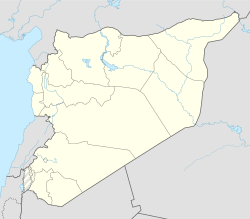Ataman, Syria
Ataman
عتمان Athman Othman | |
|---|---|
Village | |
| Coordinates: 32°39′44″N 36°6′53″E / 32.66222°N 36.11472°E | |
| Grid position | 254/230 PAL |
| Country | |
| Governorate | Daraa |
| District | Daraa |
| Subdistrict | Daraa |
| Population (2004)[1] | |
• Total | 8,929 |
| Time zone | UTC+2 (EET) |
| • Summer (DST) | UTC+3 (EEST) |
′Ataman (Arabic: عتمان), also spelled ′Atman, Athman, Osmane or Othman, is a village in southern Syria, administratively part of the Daraa Governorate, located 4 kilometers north of Daraa. Other nearby localities include al-Yadudah to the west, Tafas to the northwest, Da'el to the north, Khirbet Ghazaleh to the northeast, al-Ghariyah al-Gharbiyah to the east and al-Naimah to the southeast. According to the Syria Central Bureau of Statistics, Ataman had a population of 8,929 in the 2004 census.[1]
History
[edit]In the Ottoman tax registers of 1596, it was a village located the nahiya of Butayna, Qada of Hawran, under the name of Atman. It had a population of 29 households and 15 bachelors, all Muslims. They paid a fixed tax-rate of 40% on agricultural products, including wheat, barley, summer crops, goats and beehives; a total of 8,000 akçe.[2]
In 1838, during Ottoman rule, Ataman was listed as a khirba (ruined or deserted village) in the Nukrah region by scholar Eli Smith.[3]
Archaeology
[edit]Ataman contains a few ancient ruins that were occupied by residents in the early 20th century.[4] According to orientalists Enno Littmann and Howard Crosby Butler, Ataman was likely not an ancient town, but rather "a group of fine residences, or villas, with a common monumental tomb".[4] Among the more notable ruins are an ancient bridge and a large mausoleum. The mausoleum consists of a large stone building topped by a square structure built in the Corinthian architectural form.[5] The mausoleum is the most preserved of Ataman's ancient remains. Just north of the building are ruined structures consisting of parts of ancient columns, large windows and doorways.[4]
References
[edit]- ^ a b "General Census of Population 2004". Retrieved 2014-07-10.
- ^ Hütteroth and Abdulfattah, 1977, p. 215
- ^ Smith; in Robinson and Smith, 1841, vol 3, Second appendix, B, p. 152.
- ^ a b c Butler, Howard Crosby; Littmann, Enno (1919). Syria: Publications of the Princeton University Archaeological Expeditions to Syria in 1904-5 and 1909. E. J. Brill.
- ^ Boulanger, 1966, p. 503.
Bibliography
[edit]- Boulanger, Robert (1966). The Middle East, Lebanon, Syria, Jordan, Iraq, Iran. Hachette.
- Hütteroth, W.-D.; Abdulfattah, K. (1977). Historical Geography of Palestine, Transjordan and Southern Syria in the Late 16th Century. Erlanger Geographische Arbeiten, Sonderband 5. Erlangen, Germany: Vorstand der Fränkischen Geographischen Gesellschaft. ISBN 3-920405-41-2.
- Robinson, E.; Smith, E. (1841). Biblical Researches in Palestine, Mount Sinai and Arabia Petraea: A Journal of Travels in the year 1838. Vol. 3. Boston: Crocker & Brewster.
External links
[edit]- Map of the town, Google Maps
- Deraa-map, 22L

